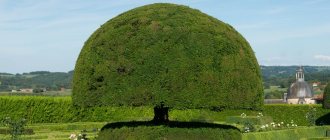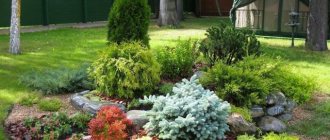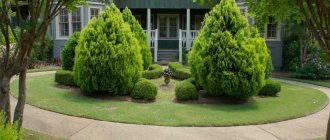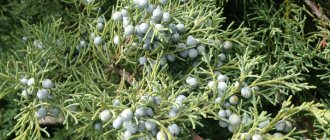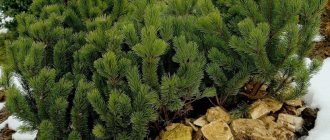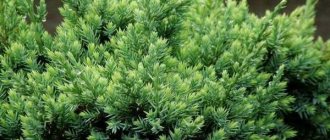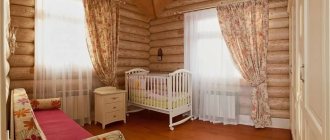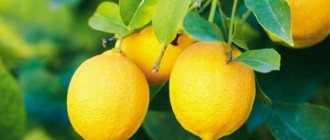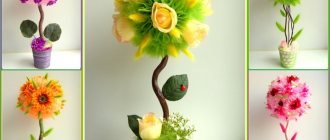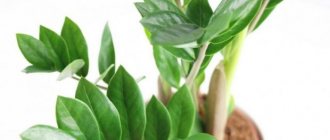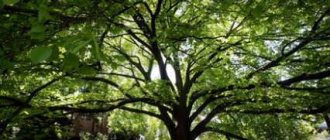When creating conditions for growing larch on a personal plot, be sure to ensure that decorative flowering or rare collection plants are not planted nearby. The thing is that although larch is a coniferous tree, in the winter it completely sheds its needles, as a result of which the entire soil along the diameter of the crown is densely covered with yellowed needles.
Larix larch belongs to the Pine family (Pinaceae). The genus is represented by 10-15 closely related species, growing in the temperate and cold zones of the Northern Hemisphere. In Siberia and the Far East, larches are forest-forming species.
This page describes what different types of larch trees look like and how to care for these plants.
Description of larch and use in landscape design (with photo)
All types of larches are similar in appearance to large deciduous trees with horizontal, widely and unevenly spaced, and sometimes hanging branches. The first thing worth noting when describing larches is the strength of the trees and their branched root system. They will grow up to 50 m in height. Some specimens live to be five hundred years old or more. The bark is roughly wrinkled and thick. The needles are needle-shaped, flat, thin, soft, light green or bluish. Male “flowers” are single, rounded or ovoid, formed at the ends of short leafless shoots.
As you can see in the photo, the cones of the larch tree are small, oblong-ovate, young ones are green or purple, mature ones are gray-brown:
The seeds ripen and fall out in the first year, but the cones remain on the branches for several years. The percentage of fully developed seeds is small, and their germination capacity disappears in the 2-3rd year.
The larch tree is one of the most valuable industrially. The active use of wood has led to a significant reduction in the European distribution area. If in the 12th century there were vast larch forests even in central Russia, now this tree begins to dominate the forests only starting from Siberia.
All types of larches are equally valuable for garden decoration. As a rule, they are planted as tapeworms (attractive single specimens) or created into backstage groves.
Look how beautiful the compositions with larches in landscape design are in these photos:
Against the background of deciduous larches, evergreen pines, spruces and firs look impressive. Joint planting of coniferous larch trees with the addition of deciduous trees is the main theme of classic park compositions of northern gardens. Larches can easily tolerate pruning, but are not suitable for topiary. To form a compact crown, it is possible to trim large twigs and branches in early spring or autumn, as well as shortening young growths, which causes active tillering and compaction of the crown. Young larches are flexible, elastic plants, and this allows them to bend their trunks and branches, intertwine the branches and, by fixing them on a support, change the type of their growth. By using this method and combining it with pruning, you can create “living” arches, pergolas and gazebos using larches in landscape design.
The following describes what different types and varieties of larches look like.
Botanical description
In favorable conditions, it grows up to 50 m in height with a trunk diameter of up to 1 m. It lives up to 300-400 years; larches have been recorded to be up to 800 years old.
The crowns are loose, visible through the sun, and cone-shaped in young trees. With age, they acquire a round or ovoid, blunt-topped shape. In constant winds, they are one-sided and flag-shaped.
The needles are annual, soft. Flattened, bright green, located spirally and singly on elongated shoots, and in bunches on short shoots, 20-40 (50) pieces in each. In autumn, trees completely shed their needles.
Crown shape. Siberian larch in winter
Cones in autumn
Larch is a monoecious plant. Male spikelets are round-ovoid, yellowish, 5 to 10 mm long. Stamens with two anthers. Pollen without air sacs. Female cones are reddish-pink or green. Pollination occurs simultaneously with the blossoming of the needles or immediately after their blossoming, in the south - in April - May, in the north - in June. The cones ripen in autumn in the year of flowering, have an ovoid or oblong-rounded shape and a length of 1.5 to 3.5 cm. The seed scales are hard, longer than the coverts. Mature cones open either immediately or, after overwintering, in early spring. The seeds are small, ovoid, with tightly attached wings. Fruiting begins at the age of about 15 years. Abundant seed years are repeated at intervals of 6-7 years. Seed germination is low.
Cones in summer
The root system of larch under normal conditions is powerful, branched, without a clearly defined tap root, with strong lateral roots buried at the ends, the presence of which ensures the tree's wind resistance. Sometimes there is rooting of branches in contact with the soil. In conditions of waterlogged soils, as well as in shallow permafrost, the root system is superficial. At the same time, the trees suffer from windfall. In floodplains of rivers, in moss swamps, when the root part of the trunk is buried by a growing layer of mosses or covered with a sandy-mud layer, larch forms adventitious roots.
Larch is an extremely light-loving tree; it does not renew itself or grow in shade. In favorable conditions it grows quickly. Until the age of 20, it can gain from 50 to 100 cm per year.
Larch alley in Tsarskoe Selo
Larch is resistant to spring frosts, very resistant to low winter temperatures, and undemanding to the thermal regime of the growing season - which is why it is widespread far beyond the Arctic Circle.
It is also undemanding to the soil. It grows in moss swamps, waterlogged pigweeds, near permafrost, and on dry skeletal soils of mountain slopes. In such unfavorable conditions, larch becomes stunted and stunted. Optimal soils that give larch the opportunity for best development are moist and well-drained loams or sandy loam soils on gentle slopes and river valleys.
In places unfavorable for other species - on heavy and waterlogged soils, in permafrost areas, on pigweeds - it forms pure larch plantations. Under better soil, climatic and hydrological conditions, it grows in a mixture with pine, spruce, cedar, fir, birch and other species. It colonizes burned areas and fresh clear-cut areas well. Seedlings and natural regrowth are almost not damaged by rodents.
Popular types and varieties of larch: photos and descriptions
Widely popular in cultivation and absolutely frost-resistant are European larch (L. decidua), Gmelin larch (L. gmelinii), American larch (L. laricina).
Larix decidua - Deciduous larch, or European larch.
It grows in the mountains of Central Europe, occupies large areas and reaches the level of alpine meadows. It has many cultivars of different habitus and growth type.
Recommended varieties of European larch:
Larix decidua Compacta.
A dwarf variety of European larch. The branches are densely pubescent, the needles are soft and green. Annual growth is within 10-12 cm. The autumn color of the needles is from golden to dark orange. Completely frost-resistant. The autumn color of the needles of this variety of European larch ranges from golden to dark orange. Completely frost-resistant.
Larix decidua Lucek.
Medium-sized variety of European larch. The branches are erect. The needles are golden in spring, pale green at the end of summer. Annual growth is 30-50 cm. The autumn color of the needles is from golden to dark orange. Completely frost-resistant.
Larix decidua Pendula.
A weeping variety of European larch. The branches are densely pubescent, cascading, brittle.
Pay attention to the photo - the needles of this larch variety are soft and green:
Annual growth is up to 70 cm. The autumn color of the needles is from golden to dark orange. Completely frost-resistant.
Larix decidua Horstmann's Recurved.
Large-sized variety of European larch. The branches are twisted, growth is irregular, some of them are erect, others are drooping. Annual growth is within 50 cm. The autumn color of the needles is from golden to dark orange. When describing this larch variety, it is especially worth noting its high frost resistance.
Larix decidua Krejci Mutation.
A dwarf variety of European larch. Growth is irregular. The branches are densely pubescent, the needles are soft and green. Annual growth within 50 cm.
Larix decidua Pali.
A weeping variety of European larch. The branches are densely pubescent, cascading, brittle. The needles are soft and green. Annual growth is up to 30 cm. The autumn color of the needles is from golden to dark orange. Completely frost-resistant.
Larix gmelinii - Gmelin larch, or Dahurian larch.
It forms thick forests in the Far East, replacing a closely related species in Eastern Siberia, L. sibirica. In the highlands it has a curved shape and dwarf growth, which is used by gardeners to create dwarf bonsai trees. The needles are tender, green, slightly bluish. It has a few varietal varieties.
Larix laricina - American larch.
Forms large forests in the mountains of North America.
As shown in the photo, the needles of this type of larch are delicate, light green:
It has cultivars of different habitus and growth type.
Recommended variety of American larch:
Larix laricina Tharandf.
Mini variety of American larch. Round shape. The needles are gray-blue, soft. The autumn color of the needles ranges from golden to dark orange. Annual growth is 5-6 cm. Completely frost-resistant.
Larix kaempferi - Kaempfer's larch.
Grows in the mountains of the Far East. The needles are tender, bluish-green. It has numerous varietal forms with gray and blue needles. Widely used to create dwarf bonsai trees.
Recommended varieties of Kaempfer larch:
Larix kaempferi Blue Ball.
Dwarf variety of Kaempfer larch. The shape is round. The needles are soft and green. The autumn color of the needles varies from golden to dark orange. Annual growth of 10 cm. Completely frost-resistant.
Larix kaempferi Cruwys Morchard.
Almost indistinguishable from Larix kaempferi Little Bogle. The branches are whip-shaped, densely pubescent. The needles are soft, gray-green. The autumn color of the needles varies from golden to dark orange. Annual growth within 10 cm. Completely frost-resistant.
Larix kaempferi Cupido.
Dwarf variety of Kaempfer larch. The shape is round. The needles are soft, gray-green. The autumn color of the needles changes from golden to dark orange. Annual growth within 10 cm. Completely frost-resistant.
Larix kaempferi Diana.
Large-sized variety of Kaempfer larch. Spreading oval shape. The branches are curved, the needles are soft and green. The autumn color of the needles varies from golden to dark orange. Annual growth is more than 30 cm. Completely frost-resistant.
Larix kaempferi Gray Pearl.
Dwarf variety of Kaempfer larch. The shape is round. The needles are soft, gray-green. The autumn color of the needles varies from golden to dark orange. Annual growth is within 5-7 cm. Completely frost-resistant.
Larix kaempferi Little Bogle.
Almost indistinguishable from Larix kaempferi Cruwys Morchard. The branches are whip-shaped, densely pubescent. The needles are soft, gray-green. The autumn color of the needles varies from golden to dark orange. Annual growth within 10 cm. Completely frost-resistant.
Larix kaempferi Mazanek.
Medium-sized variety of Kaempfer larch. The branches are curved, whip-shaped, chaotically located. The needles are soft and green. The autumn color of the needles varies from golden to dark orange. Annual growth is within 30 cm. Completely frost-resistant.
Larix kaempferi Minor.
Medium-sized variety of Kaempfer larch. The branches develop in a vertical direction, whip-like. The needles are soft and green. The autumn color of the needles varies from golden to dark orange. Annual growth within 30 cm. Completely frost-resistant,
How to grow larch in the garden
When planting and caring for larches, do not forget that these are “freedom-loving” plants. Only in an open place do they acquire the characteristic spreading shape of the crown. In shaded places and in dense plantings they are of little decorative value.
Larches are undemanding when it comes to soil; both sand and clay can be used for maintenance when growing trees, but these crops still give preference to light, fertile, slightly acidic loams.
Adult specimens have a powerful, branched root system and do not need feeding. Young plants can be fertilized in the spring after the snow melts on wet soil with complex or combined mineral fertilizer, but in no case with fresh manure and feces.
When caring for larches, replanting should be carried out either in early spring before buds open, or in autumn after the leaves turn yellow. In this case, it is possible to deepen the root collar, although it is not advisable. Plants with actively growing shoots require pruning, take root poorly and take a long time to get sick, so replanting them is not recommended.
Young larches easily tolerate replanting; large ones can be replanted only after preliminary preparation, when a dense lump is formed as a result of repeated pruning of the roots. If the plant is planned to be replanted in the fall, then pruning is carried out in the spring; for replanting in the spring, the plant is prepared in the summer of the previous year. In the process of caring for transplanted larches, you need to follow the same rules as when growing other conifers - water abundantly, and when replanting in spring, you also need to spray until the tree takes root.
Mature larches are extremely drought-resistant. Young plants require sufficient watering during the period of active growth and are able to tolerate the proximity of groundwater, but for adult plants, waterlogging is detrimental.
Most species are highly frost-resistant. Young summer shoots often suffer from late frosts, but grow back easily.
The next section of the article is devoted to how to propagate larch on a personal plot.
How to propagate larch: conditions for growing a crop from seeds
The most rational way to propagate larch is by seed. Only freshly collected seeds are suitable, but even among them the germination rate is low. When stored under normal conditions, germination is lost after a year, and sometimes even after 3-4 months, but if they are kept in an airtight container at a temperature of 0 to 5 ° C, then they will sprout after 10 or more years.
Seeds freshly fallen from cones are capable of immediate germination, since their embryo is in a stage of shallow dormancy, but dried and especially stored seeds need to awaken the embryo using stratification.
The most rational methods for sowing crop seeds are:
- Pre-winter sowing. In the autumn, immediately after collection, without drying, the seeds are sown in a ridge to a depth of 3-5 cm and mulched to a height of 1-1.5 cm. In the spring, after the emergence of seedlings, the plants are pricked up or left on the ridge until autumn or next spring.
- Snowmaking. Seeds are sown in boxes in autumn or winter, kept warm for 2-3 weeks and then taken out under the snow until spring. In spring - early summer, after the emergence of seedlings, the plants are planted in a ridge or left in boxes until autumn.
- Cold stratification. At the end of winter, the seeds are sown in boxes or bowls in an earthen mixture consisting of rotted leaf soil, peat and coarse sifted sand in a ratio of 3:1:1. The crops are kept warm for 2-3 weeks, and then stored in a refrigerator or basement at a temperature of +3 to +5 ° C for 1-2 months, maintaining an even, moderate level of substrate humidity and a constant temperature.
Stratified seeds for growing larches are transferred for germination to a bright, warm (+18...+25 °C) place. Seedlings are protected from direct sunlight and watered moderately. If the seeds have sprouted too thickly, then picking is necessary. When it gets warmer, the crops are taken out into the garden, and after hardening, they are planted in a ridge.
When growing larches from seeds, the seedlings are unpretentious and develop quickly.
Creeping forms can be propagated by horizontal cuttings, but rooting rarely occurs in the first year. Cuttings are possible, but they involve great difficulties and are ineffective.
Content
Distributed everywhere, larch avoids only the tropics. The northern beauty easily takes root both in the Far East and in the south of Primorye, delights the central regions of Russia with its delicate needles, but its favorite habitat is Siberia. The majestic tree , reaching 40 meters in height in nature, is used in landscape design .
A small larch tree complements the landscape
The house is decorated with green beautiful larch
In autumn, larch has a bright orange color
Small fluffy larch tree
Larch has voluminous fluffy branches
With the help of larch you can implement original landscape ideas
Siberian larch
This is a large tree, growing up to 40 meters in height with a trunk diameter of 1.7 meters. Its crown is narrow in the form of a pyramid, but over time it becomes more oval and rounded. In its natural environment, the tree can be found in Siberia and northern Russia. Larch is resistant to cold, strong winds and frosts, and can even grow in a moss swamp. The bark of an adult tree is very dense, brown in color, with large furrows. Young shoots are lighter yellowish-mustard in color with small furrows located along them. The needles are greenish in color with a bluish tint, about 30-35 mm long. The tree blooms in mid-spring. Flowering duration is no more than 10 days.
The cones of Siberian larch are ovoid, small, about 2-3 cm, yellowish, red or burgundy in color. The cones ripen from late summer to early autumn. Within two months they dry out, after which the seeds fall off. Representatives of the species are unpretentious in care, can grow in different soils with high and low air humidity, but at the same time they need good lighting. The tree is often grown in groups and decorated alleys, because it survives even in urban environments. There are several more varieties of Siberian larch - compact, pyramidal, weeping and blunt.
The tree bears fruit every year, but produces crops periodically - every 3-7 years. Seeds can be stored for about three years, but their germination rate is very low - 10-30%. Before planting, the seeds need to be stratified and then stored at +27°. This species is very useful; the tree bark contains tannins, and the needles contain essential oil, vitamin C and other useful elements. The seeds contain fatty oils.
Interesting varieties of Siberian larch:
- "Compact". The crown is very strong and highly branched.
- "Dulled." The crown is in the form of a cylinder with a blunt top.
- "Crying." The tops of the shoots droop.

Kinds
Larch, a member of the Pine family, shines with emerald green in summer and sparkles with light yellow needles in autumn. This is the only coniferous tree that loses its completely non-thorny needles during the winter. Long breeding work made it possible to adapt this unique plant to garden culture.
Young larch tree in a summer cottage
Today, for decorating private properties, several types of wood are offered, which include Siberian, European and Japanese larch. Let's look at each of them in more detail.
Siberian larch is a durable, light-loving and frost-resistant tree. It grows up to 40 meters, at an early age the crown is pyramidal, later it acquires an oval-round shape. It takes root well in a variety of soils, but prefers a high lime content. The needles, painted in light green tones, when blossoming, exude a pleasant aroma. Varietal variations of a tree are associated with the shape of the crown. In the compact one (f. compacta) it is dense, with dense branches closely adjacent to each other. F. decuminata or blunted is distinguished by a cylindrical crown, without a sharp apex. There are both pyramidal (f. fastigata) and weeping (f. penduda) species, respectively, also distinguished by the shape of the crown.
Siberian larch grows up to 40 meters in height
A lover of mixed forests, European larch is a close relative of the Siberian species, but differs from its sister in its cone-shaped crown, the structure of the cones and the seasonal timing of development. Breeders consider it the fastest growing of all larch species. For decoration, the long growing season of the species is especially important, allowing the creation of amazing coniferous groups. Among the varieties, it is worth highlighting the dwarf Kellermannii, which forms a coniferous bush, Pendula or weeping larch, and Repens, which spreads branches along the ground.
European larch is the fastest growing larch species.
The broad-pyramidal Japanese larch or Kaempfer larch reaches a height of 35 meters. Long needles (5cm), blue -green in color, frame the multi-peaked crown of the tree. In combination with red -brown bark it gives a stunning decorative effect. The branches of the tree are strewn with spherical cones. Gardeners note varieties such as Blue Rabbit, fast-growing and very beautiful, Diana, adorned with twisted branches, and Wolterdingen, whose crown diameter is greater than its height.
The height of Japanese larch can reach 35 meters
European larch
In its natural environment, a tree of this species can be found in the Carpathians and the Alps. This is a very sophisticated tree with a highly branched cone-shaped crown. Representatives of this species are not similar to the previous species only in the characteristics of ripe cones and the periods of their formation. The cones are brownish in color and do not open well. Cones without seeds are retained on the branches for a long time, about 10 years. European larch is known as the fastest growing tree.
Interesting varieties of European larch:
- "Viminalis". The shoots are crying.
- "Corley" Crown in the form of a pillow.
- "Repens". The shoots are elongated, spreading and crawling along the surface of the soil.
- "Cervicornis". The shoots of the plant are twisted.
- "Compacta". The needles are greenish in color.
- "Kornik". The crown of the tree is in the shape of a ball and needs formative pruning.
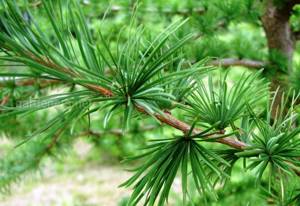
Planting and care
An unpretentious larch tree feels great both in forests and in urban jungles. The larch root system is very well developed, which allows it to survive in any type of soil, but it does not like stagnant moisture.
Larch is widely used in landscape design
Where and how to plant
For planting, we select seedlings 2-4 years old. According to the seasons, larch is planted in early spring or autumn, after the leaves have fallen. If you plan to create a wall of larch trees, the trees are planted at a distance of 2-4 meters from each other. The place should be open, with sufficient sunlight . A little shading is only permissible for the Japanese species.
Diseases and how to avoid them
The main enemy of the tree is the larch leaf miner. It makes the tree's needles flabby and white. The affected shoots are removed, and the tree is treated with insecticides based on mineral oils.
Larch and coniferous insects attack. Related to aphids, they are covered in white bristles and are easy to spot. Scale insects actively reproduce in dry weather, when there is no rain for a long time. Insecticides will also help get rid of them.
Healthy lush larch tree
There is a risk of frost damage to young shoots, but this is not detrimental to the plant. Remembering how to plant larch, you can take this factor into account and temporarily cover the seedlings with spruce branches. However, the shoots quickly recover from such a blow.
The larch crown creates cool shade in the heat
Larch will definitely stand out with its majesty among other plants
Larch branches beautifully spread along the stone border
A larch tree decorates the country courtyard
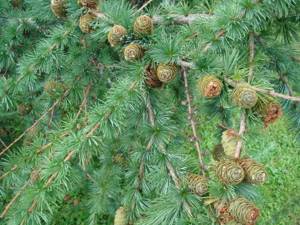
Despite the fact that the coniferous larch tree loses all its needles with the onset of cold weather, it does not lose its attractiveness. Small cones remain on its branches, giving the plant a certain aura of mystery. In natural habitats it can reach a height of 50 meters; individual specimens live up to 400 years. Check out the names, photos and descriptions of the types of larch that are most popular among gardeners.
What larch looks like: the appearance of the tree and its photo
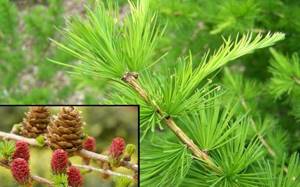
Larch in the photo
Larch is a monoecious coniferous plant of the pine family. Unlike other conifers, larch sheds its needles annually, at the same time as deciduous trees. Larch is widespread in the Northern Hemisphere (Europe, Asia, America) in cold, temperate and partially subtropical zones.
Look at the photo - the larch tree at a young age has a pyramidal crown, and then, as it ages, it becomes rounded:
Branching is not typical for conifers; it is an unclear whorl, rather a spiral arrangement of needles and branches.
There are two types of branches - elongated vegetative and shortened generative. On one tree there are both female and male flowers. Shortened fruit branches differ from elongated ones in terms of needles. On them the needles sit in 20-60 pieces, and on the growth ones one by one and in a spiral. The needles are small, flattened.
Shortened shoots die off after 10-12 years, but, depending on conditions, they may not die off, but grow into full-length shoots.
The larch tree deserves a special description during fruiting, when spherical spikelets of different sizes appear on one shoot - male and female. What does larch look like during this picturesque period? Male balls are yellowish and sit on very short shoots. Women's cones are larger than men's. They also appear on shortened shoots and simultaneously with male shoots. At the base they are surrounded by sparse needles. Flowering occurs in early spring, simultaneously with bud break.
The cones ripen in the fall of the flowering year. After the seeds fall out, they can hang on the tree for another 2-4 years. The seeds are light, round, with wings. They are often empty and unfertilized, which affects their low germination rate.
These photos show what larch looks like in winter and summer:
Daurian larch, or Gmelina
This is a low growing tree. Its branches are very spread out, which is why the tree seems multi-vertexed and looks like a huge ornamental shrub. The bark is reddish with deep furrows. The cones are male and female, ripen at the beginning of autumn and at the same time the seeds fall out of them. The buds are yellowish-golden, and the needles are a rich green color. It is these latter characteristics that distinguish this species from others. All varieties of the species are unpretentious in care; they can be propagated by seed or by layering. Germination is high for larch – 60%. The root system of the tree is very plastic; it is able to germinate in swampy soil and form surface roots.
Decorative qualities of larch wood (with photo)
Larch is a very original tree and, despite the fact that it is deciduous, retains its decorative appearance throughout the year.
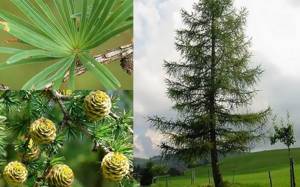
In spring, the crown is decorated with golden, mimosa-ball-like male cones and greenish-yellow, pink or violet-purple female needles with a tuft at the base. They give the appearance of larch great beauty and grace.
As the needles grow massively, the ornamental larch tree becomes greener, the crown becomes lush and luxurious.
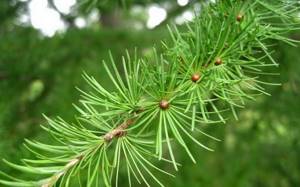
In summer, the crown, with all its foliage, remains openwork and airy due to the different types of leaf cover of the shoots.
Shortened shoots form needles in bunches, and elongated shoots form single needles. It is not without reason that larch forests are called light coniferous due to this quality.
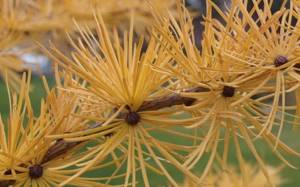
As you can see in the photo, decorative larch is incredibly beautiful in the fall. Its crown turns yellow with various shades - from lemon-golden to copper.
The needles fall off gradually in the fall. Unlike spruce falling, it does not acidify the soil, but, on the contrary, enriches it with calcium. Therefore, larch is considered a soil-improving species.
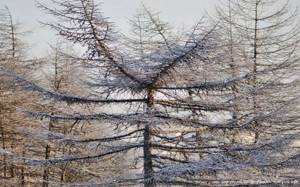
The winter appearance of larch is not attractive at first glance.
But take a closer look: the whole tree is as if shrouded in a lacy haze, which is created by thin yellow branches with small nodules like warts and small, graceful cones.
More than 20 species of larch are known, about 14 species grow in Russia, but the following six species are the most common.
Larch is a coniferous or deciduous tree
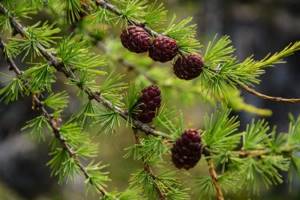
Biological types of trees are divided according to the type of leaves into coniferous and deciduous, which are also commonly called broad-leaved.
Types of trees
Deciduous trees have flat leaves that fall off in the fall. These trees bloom and can bear fruit. Coniferous trees have hard, needle-shaped leaves called needles. They grow cones or juniper berries.
Based on the lifespan of leaves, evergreen and deciduous trees are distinguished.
Deciduous trees lose their leaves in the fall, have no leaves on the trees in the winter, and new leaves emerge from the buds in the spring. Evergreen trees do not have a specific time for changing leaves. Old leaves are replaced by new ones gradually throughout the life of the tree.
Deciduous trees: names, description
Deciduous plants appeared on our planet after coniferous plants. Deciduous trees have leaves of different shapes and sizes, the color of which changes in the fall. Gradually, towards winter, the leaves fall from the trees.
There are many types of deciduous trees, for example:
- Oak
- Beech
- Birch
- Elm
- Hornbeam
- Willow
- Chestnut
- Alder
- Linden
- Poplar
- Ash
- Acacia
A quarter of European forests are made up of deciduous trees.
Oak leaves are wider at the top than at the bottom. Beech: trunk diameter – 2 m, height – up to 30 m, lifespan exceeds the threshold of 400 years. Beech leaves have a more strict shape (oval), unlike oak leaves.
Read “The Lifespan of Trees”...
Coniferous trees: names
Some will be surprised to learn that the needle (the same “needle”) is a leaf, simply modified. Let us note the main types of coniferous trees:
- Larch
- Thuja (western, eastern)
- Scots pine
- Fir
- Spruce (gray, European)
- Cedar
- Yew
- Juniper
Spruce (evergreen tree): trunk diameter reaches 1.5 m, height – up to 40 m, life expectancy – up to 500 (less often up to 600) years.
Needles: length – up to 3 cm, width – up to 1.5 mm. Norway spruce grows in Siberia, central and northern Europe.
Larch is very common in our country, as well as throughout the world.
Despite its name, larch is a coniferous tree, but not an evergreen tree. Larch needles (soft to the touch) fall off once a year before winter.
Our tree grows in the Far East and Siberia.
- Larch trunk diameter – up to 1 m,
- height – up to 50 m,
- The duration of growth is more than 400 years (there are larches that are slightly less than 800 years old).
A special dye for hides and fabrics is made from larch bark. Larch wood has the following qualities:
- durability;
- high strength of the material (only slightly inferior to oak wood).
If it is impossible to hammer a nail into dried larch wood, then removing a nail hammered into the material before it has had time to dry will also not work. Thanks to these qualities, larch is widely used in both the chemical and construction industries. But this applies mostly to American larch species.
In our country, due to the very high density of most types of larches, processing and use in construction are extremely difficult.
Larch at the dacha
Polish larch and Japanese larch are plant species cultivated in our country. Japanese larch has been grown in Russia since the end of the 19th century. In Europe, the tree can often be found in parks and gardens. Since the plant is resistant to diseases and pests, it is grown as an ornamental, and in Japan (the plant’s homeland) it is used as a bonsai.
Polish larch, except in the forest, can be observed in botanical gardens and parks (height - 30 m, lifespan exceeds half a century). The tree grows quickly, loves light and is resistant to low temperatures. In general, it is very difficult to grow larch in the countryside on your own, even more difficult than pine or spruce. The plant survives transplantation with great difficulty. Therefore, seeds are mainly used for propagation.
We recommend reading on this topic: Coniferous trees photos and names for children
